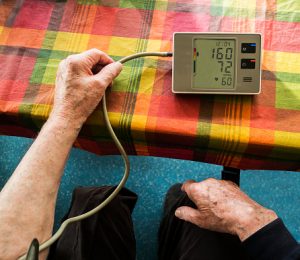
Diastolic reading is the bottom number. It is always lower and tells us the pressure on the arteries between heartbeats. This is the time when the heart refills with blood.
Systolic is the top number which is always higher. It reveals the amount of pressure on the arteries while the heart beats. An example of systolic and diastolic blood pressure reading would be 120/80 mm Hg (normal blood pressure).
The American Heart Association has set up guidelines for blood pressure so you can stay healthy and avoid hypotension and hypertension:
- Hypotension (too low): Below 90/60 mm Hg
- Normal: Below 120/80 mm Hg
- Prehypertension: 120/80 to 139/89 mm Hg
- Hypertension stage 1: 140/90 to 159/99 mm Hg
- Hypertension stage 2: Over 160/100 mm Hg
- Hypertension crisis: 180/110 mm Hg – immediate medical attention is required.
Usually, more attention is given to systolic blood pressure, because it is associated with greater health risks, especially among seniors.
Measuring systolic and diastolic blood pressure
Blood pressure can fluctuate numerous times throughout the day for many reasons, including standing up, sitting down, eating a meal, or being stressed. Checking your blood pressure at home is effective because you can find out what is your norm by taking measurements at different times throughout the day. If you wait for your doctor to check your blood pressure, you could be missing out on elevations that may occur outside of the doctor’s office and could indicate a problem.
Checking your blood pressure at home is an easy task and requires just a simple automatic blood pressure measuring device. Wrap the upper arm with a cuff, push a button, and the device will do the rest of the work for you. It’s that simple. Your reading will appear promptly on the screen. Keep a log of your blood pressure readings for further comparison.
When your blood pressure is being measured, your arm should be at the level of your heart. If the arm is hanging down, whether you are sitting or standing, it should be extended out. If you are lying down, the arm should be along your side, leveled with your body.
Aside from being aware of your arm position, here are some other tips to keep in mind when having your blood pressure measured:
- Rest for about five minutes before the reading is taken.
- Try not to eat or exercise for 30 minutes before a screening.
- Have your reading in the morning, since your body rhythms can cause blood pressure to rise in the afternoon and evening.
- Have your pressure taken from all three positions: sitting, standing, and lying down.
- Have your blood pressure taken three times in one session with one minute of rest between each test.
Don’t get caught up in comparing your blood pressure to others. Keep in mind that there is a healthy blood pressure level for each sex and age group. Here you can find an age and gender chart you can check to see what your healthy range is.
By frequently checking your blood pressure, you can track your progress and take steps to lower it if it’s high. You can also share your records with your doctor who can then take a deeper look into any possible health issue.
Speak to your doctor about device recommendations and tips on how to properly measure your blood pressure at home. Avoid alcohol or caffeine prior to checking your blood pressure. Don’t take your readings immediately after you’ve performed any physical activity. Lastly, always remember to document your numbers for your records.
Low and high systolic blood pressure
Low systolic blood pressure, also referred to as hypotension, is a condition in which adequate oxygen cannot reach vital organs. As a result, nutrients are not provided to cells and waste cannot be removed. Low systolic blood pressure is considered a reading below 90 mm Hg.
In high systolic blood pressure, or hypertension, the reading exceeds 140 mm Hg with a diastolic reading of over 90 mm Hg.
Chronic high blood pressure can result in damage to tissues and organs. Blood vessels can become scarred and rigid, increasing the risk of obstructions or even ruptures.
Low and high diastolic blood pressure
Low diastolic blood pressure is a reading below 60 and high diastolic blood pressure refers to a reading higher than 90. Similar to the cases of low and high systolic blood pressure, when diastolic pressure is too low nutrients and oxygen cannot be provided throughout the body, and when it’s too high tissues and organs can get damaged.
As you can see, for optimal health, it’s important that your systolic and diastolic blood pressure numbers stay within a healthy range. This way you lower your risk of health complications, especially those affecting your heart.
Related: Surprising causes of high blood pressure, simple strategies to manage hypertension